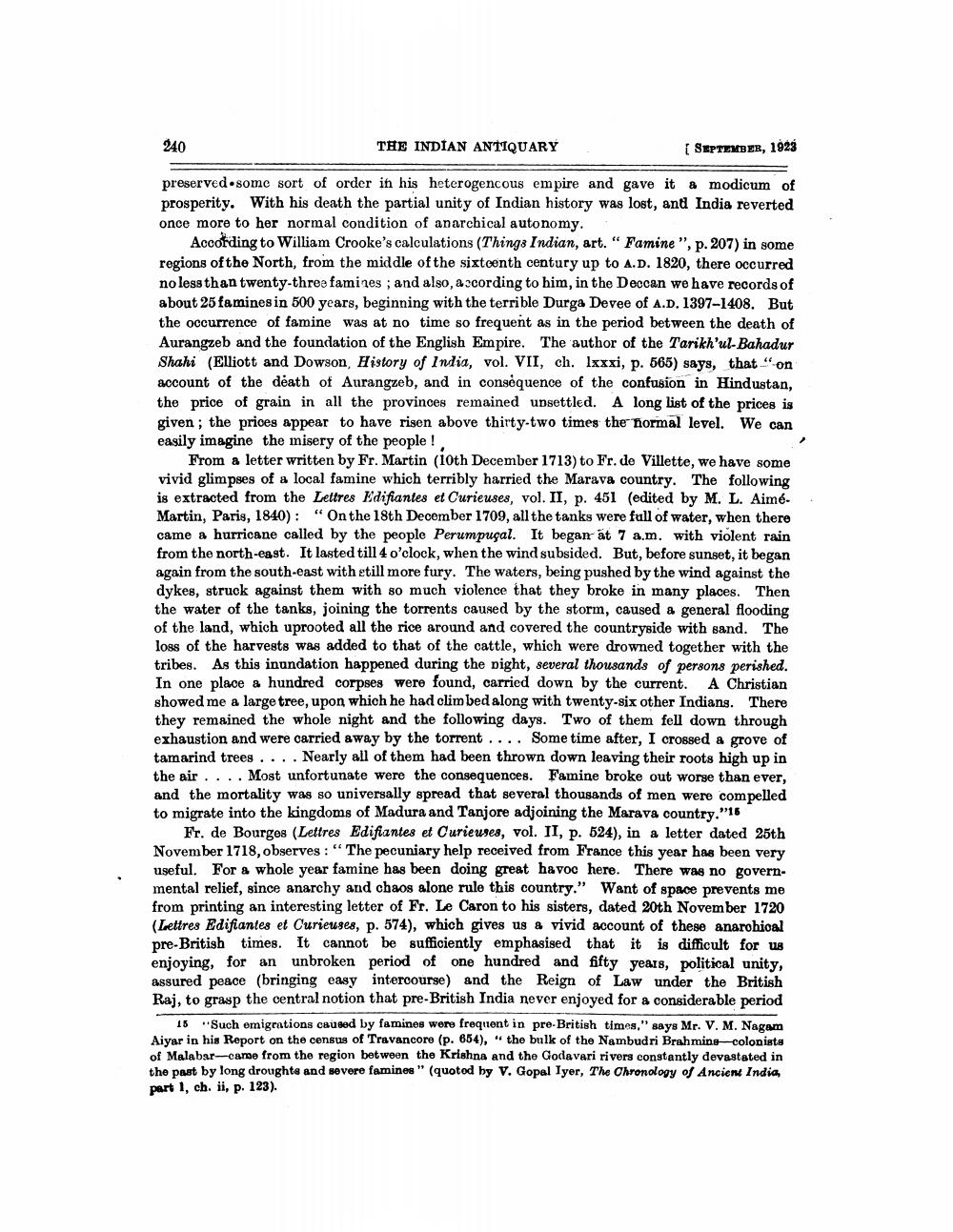________________
240
THE INDIAN ANTIQUARY
( SEPTEMBER, 1925
preserved.some sort of order in his heterogencous empire and gave it a modicum of prosperity. With his death the partial unity of Indian history was lost, and India reverted onoo more to her normal condition of anarchical autonomy.
According to William Crooke's calculations (Things Indian, art. "Famine", p. 207) in some regions of the North, from the middle of the sixteenth century up to A.D. 1820, there occurred no less than twenty-three famines, and also, ascording to him, in the Deccan we have records of about 25 famines in 500 years, beginning with the terrible Durga Devee of A.D. 1397-1408. But the occurrence of famine was at no time so frequent as in the period between the death of Aurangzeb and the foundation of the English Empire. The author of the Tarikh'ul-Bahadur Shahi (Elliott and Dowson, History of India, vol. VII, ch. lxxxi, p. 565) says, that "on account of the death of Aurangzeb, and in conséquence of the confusion in Hindustan, the price of grain in all the provinces remained unsettled. A long list of the prices is given; the prioes appear to have risen above thirty-two times the normal level. We can easily imagine the misery of the people!
From a letter written by Fr. Martin (10th December 1713) to Fr. de Villette, we have some vivid glimpses of a local famine which terribly harried the Marava country. The following is extracted from the Lettres Edifiantes et Curieuses, vol. II, p. 451 (edited by M. L. Aimé. Martin, Paris, 1840): “On the 18th December 1709, all the tanks were full of water, when there came a hurricane called by the people Perumpugal. It began at 7 a.m. with violent rain from the north-east. It lasted till 4 o'clock, when the wind subsided. But, before sunset, it began again from the south-east with etill more fury. The waters, being pushed by the wind against the dykes, struck against them with so much violence that they broke in many places. Then the water of the tanks, joining the torrents caused by the storm, caused a general flooding of the land, which uprooted all the rice around and covered the countryside with sand. The loss of the harvests was added to that of the cattle, which were drowned together with the tribes. As this inundation happened during the night, several thousands of persons perished. In one place a hundred corpses were found, carried down by the current. A Christian showed me a large tree, upon which he had climbed along with twenty-six other Indians. There they remained the whole night and the following days. Two of them fell down through exhaustion and were carried away by the torrent . . . . Some time after, I crossed a grove of tamarind trees .... Nearly all of them had been thrown down leaving their roots high up in the air . . . . Most unfortunate were the consequences. Famine broke out worse than ever, and the mortality was so universally spread that several thousands of men were compelled to migrate into the kingdoms of Madura and Tanjore adjoining the Marava country."16
Fr. de Bourgos (Lettres Edifiantes et Curieuses, vol. II, p. 624), in a letter dated 25th November 1718, observes: "The pecuniary help received from France this year has been very useful. For & whole year famine has been doing great havoc here. There was no governmental relief, since anarchy and chaos alone rule this country.” Want of space prevents me from printing an interesting letter of Fr. Le Caron to his sisters, dated 20th November 1720 (Lettres Edifiantes et Curieuses, p. 574), which gives us & vivid account of these anarohioal pre-British times. It cannot be sufficiently emphasised that it is difficult for us enjoying, for an unbroken period of one hundred and fifty years, political unity, assured peace (bringing easy intercourse) and the Reign of Law under the British Raj, to grasp the central notion that pre-British India never enjoyed for a considerable period
18 Such emigrations caused by famines were frequent in pre- British times," says Mr. V. M. Nagam Aiyar in his Report on the census of Travancore (p. 654), "the bulk of the Nambudri Brahmins-colonists of Malabar-came from the region between the Krishna and the Godavari rivers constantly devastated in the past by long droughts and severe famines" (quoted by V. Gopal Iyer, The Chronology of Ancient India, part 1, ch. ii, p. 123).




